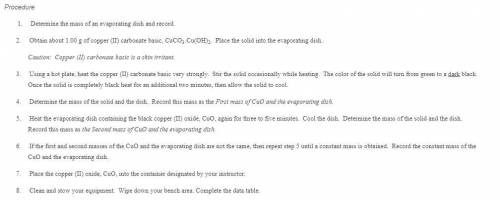
Chemistry, 01.02.2021 07:40 cheergirl2133
Calculate the theoretical yield for your reaction. {This is your predicted mass of CuO produced based on the starting mass of CuCO3Cu(OH)2}
Identify the Experimental Yield of your reaction (the amount that actually got produced and measured)
Calculate the percent yield of your reaction (refer to the introduction)
Evaluate your percent yield – state at least one legitimate reason your yield could be higher or lower than 100%. Be specific (the experimental error is not specific enough, for example)


Answers: 3


Other questions on the subject: Chemistry

Chemistry, 22.06.2019 14:30, joejoefofana
Consider the reduction reactions and their equilibrium constants. cu+(aq)+e−↽−−⇀cu(s)pb2+(aq)+2e−↽−−⇀ pb(s)fe3+(aq)+3e−↽−−⇀fe(=6.2×108=4. 0×10−5=9.3×10−3 cu + ( aq ) + e − ↽ − − ⇀ cu ( s ) k =6.2× 10 8 pb 2 + ( aq ) +2 e − ↽ − − ⇀ pb ( s ) k =4.0× 10 − 5 fe 3 + ( aq ) +3 e − ↽ − − ⇀ fe ( s ) k =9.3× 10 − 3 arrange these ions from strongest to weakest oxidizing agent.
Answers: 3

Chemistry, 22.06.2019 17:40, aaliyahthomas37
Which statement about hf is true? it is zero for any compound in its standard state. it is positive when the bonds of the product store more energy than those of the reactants. it is negative when a compound forms from elements in their standard states. it is zero for any element that is in the liquid state.
Answers: 1
You know the right answer?
Calculate the theoretical yield for your reaction. {This is your predicted mass of CuO produced base...
Questions in other subjects:




Mathematics, 08.02.2021 17:20

Mathematics, 08.02.2021 17:20

Biology, 08.02.2021 17:20


Biology, 08.02.2021 17:20


Mathematics, 08.02.2021 17:20



